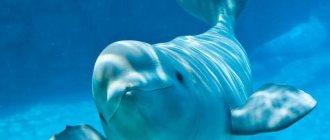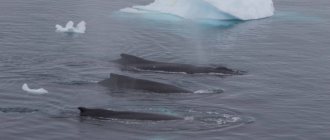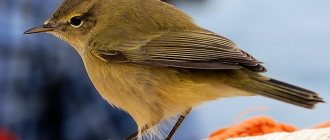The beluga whale is a mammal of the dolphin family of the suborder odontocetes. This species is a polar dolphin, whose habitat is located in the seas of the Arctic Ocean. Beluga whales are also found in mighty northern rivers that flow into the ocean, for example, in the waters of the Yenisei, Lena, and Ob. The beluga whale is able to swim upstream these rivers for tens of kilometers, but still prefers to live in the vastness of the ocean, which is rich in fish necessary to feed the animal.
Geographic range and habitat
Beluga whales live in cold Arctic and subarctic regions, swimming in deep coastal waters off the coasts of Northern Canada, Alaska, Western Greenland, Norway and Northern Russia. In summer, they can be observed in the waters of the St. Lawrence River, in the immediate vicinity of the Shantar Islands and Sakhalin Island (in the Sea of Okhotsk), as well as at the mouth of the Amur River.
Photo: Harbor Branch Oceanographic Institute
The habitat of white whales includes bays, fjords, channels and shallow Arctic seas. In summer, they are also observed in estuaries, where they feed, communicate and give birth. Here the water temperature usually varies from 8 to 10 degrees Celsius.
Beluga whales migrate seasonally. When the areas where the animals live in the summer freeze in autumn, they move out to the open sea, covered only by cracked drift ice. After the thaw, white whales migrate to shallower coastal waters (1-3 meters deep), but sometimes they choose deeper areas. In summer, they also inhabit areas of the continental shelf and often swim into river mouths. Beluga whales have been recorded many times swimming hundreds or even thousands of kilometers from the ocean coast.
Beluga whales also monitor the migration of fish (especially salmon). Rivers are the safest refuge for baby white whales, as their archenemies, killer whales, typically stay away from inland waters.
Breaking thin ice...
But these animals spend the winter clinging to the edge of the ice fields. But schools of beluga dolphins can also climb into glaciated zones, because strong winds form ice creases there. But if the glaciation becomes too strong, then polar whales can swim south en masse.
Actually, during the cold season, polar whales maneuver between ice floes, being able to exist only in ice holes and clearings. The fact is that when living underwater, they constantly need air, so beluga whales come up to breathe. It’s interesting that beluga dolphins even maintain these holes for respite so that they don’t freeze. Polar whales are able to break through thin ice with their backs – up to 10 centimeters thick.
But, unfortunately, sometimes a herd of beluga whales can become captive in the ice. It happens that ice holes are covered with very dense ice, and this is a tragedy for belugas - they simply die under water...
Appearance
Photo: Gretchen Freund
The spindle-shaped, elongated body of the beluga whale tapers more in the tail region than in the head region. The narrowing at the base of the skull (neck) gives the impression of having shoulders, which sets the beluga whale apart from other cetaceans. The pectoral fins are widely spaced, short and rounded. The caudal fin is heart shaped.
Like most toothed whales, the beluga also has a melon located on its forehead, which allows it to use echolocation. Melons contain semi-liquid fatty tissue. Unlike other cetaceans, white whales have a very characteristic melon outline - it is shaped like an onion. Interestingly, the melon is deformable - its shape changes along with the sounds it makes.
Unlike dolphins, the beluga whale's cervical vertebrae are not fused, which allows the animal to turn its head without turning its entire body. As a result, the white whale has greater visibility, hunts more efficiently, and can deftly evade attacks from predators. Beluga whales have small, blunt and slightly crooked teeth, with a total of 36-40 teeth on each jaw. They are not designed for chewing, but for catching prey, which belugas swallow whole.
Photo: Andrey Nekrasov
The thyroid glands of white whales are much larger than the glands of land mammals: they are 3 times heavier than the thyroid glands of horses, which allows the beluga whale to increase its metabolism in the summer while living in estuaries. Increased metabolism has been shown to aid the seasonal regeneration of beluga whales' epidermis.
On the top of the head of white whales, behind the melon, a spiracle is clearly visible, surrounded by smooth muscles that allow the animal to close it tightly under water. The dorsal fin has disappeared as a result of evolution, leaving a noticeable “hump”, which, in combination with a powerful head, allows air holes to be made in ice up to 8 cm thick.
Coloring
The adult cannot be confused with any other species of cetacean, because only this whale is completely white or white-gray. However, its cubs are born gray, becoming gray-blue after a month. They gradually lose their coloration, acquiring a bright white skin color. The final coloration is formed at 7 years (females) and 9 years (males).
Photo: Steve Snodgrass
The coloration is a result of adaptation to life in the Arctic, as it should provide good camouflage in the polar ice cap, protecting beluga whales from killer whales and polar bears - the main predators that hunt these beautiful mammals.
In winter, the epidermis thickens: the skin becomes yellowish, mainly in the back and on the fins. In the summer, after migrating to river mouths, beluga whales rub against gravel at the bottom of river beds to shed old skin. Thus, the beluga whale is the only cetacean that sheds its skin.
Danger
The enemies of these dolphins are considered to be the polar bear and killer whale, which are powerful predators. In winter, the land hunter settles down near large thawed patches in the middle of the ice in anticipation of the moment when his prey comes up for air. As soon as the beluga sticks out its head, at the same time a powerful and clawed paw stuns it with a strong blow. After this, the bear takes the unconscious body onto the ice and eats it.
The second enemy of these animals is also not against feasting on their thick fat layer. Therefore, killer whales do not miss an opportunity to attack dolphins underwater. It is not possible for a beluga whale to escape from such a hunter, since it swims twice as slow as this predator.
Dimensions
White whales are on average 4.5 meters long and weigh up to 1,600 kg. The record weight was recorded at 1,900 kg! Fifty percent of beluga whales' weight is fat, which is noticeably higher than other Nearctic whales, whose bodies are only twenty percent fat. The thickness of beluga whales is 10 cm. Beluga whales are characterized by sexual dimorphism: males are slightly larger than females.
- Body length: 3.5-5.5 meters (males), 3-4.1 meters (females)
- Weight: 1100-1600 kg (males), 700 - 1200 kg (females)
Notes
- Sokolov V. E.
Five-language dictionary of animal names. Mammals. Latin, Russian, English, German, French. / under the general editorship of academician. V. E. Sokolova. - M.: Rus. lang., 1984. - P. 117. - 10,000 copies. - Pavlinov I.Ya.
Systematics of modern mammals. - M.: Publishing house of Moscow University, 2003. - P. 221-222. — 297 p. - Marine mammals of the World. FAO Species Identification Guide. p.76-77
- ↑ 1234
Animals: mammals of Russia, 2013, p. 74. - ↑ 1234
Animals: mammals of Russia, 2013, p. 75. - [www.gramma.ru/RUS/?id=14.5 Culture of written speech. RUSSIAN LANGUAGE - Roar like a beluga]
- [www.sevin.ru/vertebrates/index.html?Mammals/299.html Vertebrates of Russia: Beluga]
- Pasternak B. L. Poems and poems: In 2 vols. - L.: Soviet writer, Leningrad department, 1990. - T. 2. P. 242. (“Poet’s Library”, Large series, 3rd ed.).
- Sasha Cherny. Collected works in 5 volumes. - M.: Ellis Luck, 1996. - T. 1. P. 171.
- Sasha Cherny. Collected works in 5 volumes. - M.: Ellis Luck, 1996. - T. 2. P. 156-157.
- Chukovsky K.I. Poems. - St. Petersburg: Academic Project, 2002. - P. 359. (“New Library of the Poet”).
- [rian.ru/kaleidoscope/20090729/179095679.html In China, a white whale saved a drowning diver] - RIAN news based on [www.telegraph.co.uk/news/newstopics/howaboutthat/5931345/Beluga-whale-saves-diver.html The Telegraph]
Communication and perception
White whales communicate often. Their voices are so loud that they have been compared to the shrill calls of birds, for which they were once nicknamed “canaries of the sea.” They are considered one of the noisiest cetacean species. Beluga whales use their vocalizations for echolocation, mating and communication. Their voices are like chirping and whistling. Beluga whales also use body language to communicate, such as grinding their teeth or splashing.
Hearing
This is one of the most developed senses of beluga whales. She can hear sounds in the range of 1.2 to 120 kHz, being most sensitive to frequencies from 10 to 75 kHz (the average human hearing range is 0.02 -20 kHz).
Vision
White whales have good vision both above and below water, but their vision is quite poor compared to dolphins. The eyes are best adapted to see underwater, and when exposed to atmospheric air, vision is impaired, although the visual system can adapt to different conditions.
The eye contains both rods and cones, which is why the animal is apparently able to see even in low light conditions. Glands located in the inner corners of the eyes secrete a fatty, jelly-like substance that lubricates the eyeball and allows foreign objects to be removed.
Touch, taste, smell
Photo: David Merron
It has been observed that beluga whales enjoy maintaining physical contact (not to be confused with sexual relations) with other beluga whales. Their mouths contain so-called chemoreceptors, which allow them to distinguish between different tastes. In addition, a beluga whale can taste blood in the water - in such a situation it panics. Like other toothed whales, the beluga whale lacks an olfactory brain and olfactory nerves, so it has absolutely no sense of smell.
Beluga roar
In the Russian language there is a phraseological unit “to roar as a beluga,” associated with the loud sounds that a beluga whale makes. In the 19th century, two variants of spelling the name of this animal were common: “beluga” and “beluga”. In modern language, the word "beluga" has the main meaning - beluga fish[6], but for a mammal "beluga" is also used[7].
Beluga roar in Russian classics
He accompanied non-doctors to the hallway - evenings, Contrary to the announcement, ready to serve Only on white nights, when he thought until the morning, and the stations roared like belugas.
B. Pasternak.
From Spectorsky's notes. [8]Stupid Michel with his magnificent wife Minces and waves his cap, The white clown breaks into a beluga And threatens someone with his fist.
Sasha Cherny.
Carnival in Heidelberg. [9]The steamboat roars like a beluga, the Eiffel Tower is in the clouds... Who would choose me as Miss Kaluga this year!
Sasha Cherny.
Parisian ditties. II. [10]They were bitten by a hippopotamus, and in pain the hippopotamus, with its mouth open like a gate, fell into the swamp and roared like a beluga.
K. Chukovsky.
Let's defeat Barmaley! (War tale). [eleven]I was very happy, but, crouching by the stump, I howled like a beluga and cursed fate, - A German sniper finished shooting me, killing the one who did not shoot.
V. S. Vysotsky. "The One That Didn't Shoot" (1973).
Diet
The beluga whale is an opportunistic species of mammal. She hunts for any prey that is easiest and fastest to catch. Its feeding habits depend on the subpopulation and the season of the year. Beaufort's white whales may feed on the Arctic Terek, while those found in the Greenland area prey on red fish, northern shrimp and Greenland halibut.
Photo: Pond5
Alaskan subpopulations primarily prefer Pacific salmon. Beluga whales happily hunt capelin, flounder, smelt and gobies. They also feed on invertebrates such as crabs, shrimp, molluscs, sea snails, worms, octopuses, squid, polychaetes and other deep-sea species. These mammals in captivity eat 2.5-3% of their body weight daily, that is, 18.2-27.2 kg of fish.
Typically, the white whale hunts at a depth of 20 to 40 meters. The flexible neck allows for a full range of motion while searching for food on the seabed. Beluga whales often hunt in groups of 4-5 individuals, this makes it easier to drive schools of fish into shallow water and subsequently attack them.
Lifestyle
The beluga whale (dolphin) prefers to live in schools, which, in turn, are formed by several small groups numbering from ten to one hundred animals. In the spring, mammals swim to the cold northern shores, where they spend all the warm seasons, since at this time of year there are many different fish in the shallow waters.
During the same time period, dolphins begin molting, during which the upper dead layer of skin slides off in whole flaps.
When the harsh cold weather characteristic of the Arctic sets in, the beluga whale (dolphin) leaves the coastal areas and swims to places where many drifting glaciers accumulate.
These mammals can stay underwater without air for a maximum of half an hour, but generally they emerge every two minutes. They navigate with the help of well-developed hearing or organs of chemical and sensory perception located on the surface of the tongue. They can hear the impacts of oars on the water coming from afar, the splash of waves on the ice and many other sounds that warn them of approaching danger.
Diving
Although the beluga whale is a close relative of the common bottlenose dolphin, it does not usually jump above the surface of the water. The beluga whale spends five to ten percent of its time on the surface of the water. It usually swims quite slowly: 3-9 km/h, but can reach a maximum speed of 22 km/h, which it can maintain for 15 minutes. White whales can even swim backwards.
Almost 90% of the time the beluga whale is under water. White whales usually dive to depths of up to 20 meters, although they are capable of penetrating to much greater depths - from 400 to 700 meters. The deepest beluga whale diver was recorded at a depth of 872 meters. One dive usually lasts 3-5 minutes, but can last up to 15-18 minutes. In shallow river mouths, the average dive lasts about 2 minutes; it consists of 5-6 quick shallow dives followed by a deeper one-minute dive. The beluga whale dives 30-50 times a day.
During a dive, the animal's heart rate drops from the usual 100 beats per minute to 12-20 beats per minute. Only the most vital organs are supplied with blood: the brain, heart and lungs, which require a constant flow of oxygen. In addition, beluga whale muscles have a very high level of a certain protein - myoglobin, which is responsible for storing oxygen inside the muscles. The concentration of this protein in the muscle mass of the white whale is several times higher than that of land mammals, which helps to avoid oxygen deficiency during a dive.
Excerpt characterizing Belukha (mammal)
He waited to see if the cornet would answer. But the cornet turned and left the corridor. The Pavlograd Hussar Regiment was stationed two miles from Braunau. The squadron, in which Nikolai Rostov served as a cadet, was located in the German village of Salzenek. The squadron commander, captain Denisov, known throughout the cavalry division under the name Vaska Denisov, was allocated the best apartment in the village. Junker Rostov, ever since he caught up with the regiment in Poland, lived with the squadron commander. On October 11, the very day when everything in the main apartment was raised to its feet by the news of Mack's defeat, at the squadron headquarters, camp life calmly went on as before. Denisov, who had lost all night at cards, had not yet come home when Rostov returned from foraging early in the morning on horseback. Rostov, in a cadet's uniform, rode up to the porch, pushed his horse, threw off his leg with a flexible, youthful gesture, stood on the stirrup, as if not wanting to part with the horse, finally jumped off and shouted to the messenger. “Ah, Bondarenko, dear friend,” he said to the hussar who rushed headlong towards his horse. “Lead me out, my friend,” he said with that brotherly, cheerful tenderness with which good young people treat everyone when they are happy. “I’m listening, your Excellency,” answered the Little Russian, shaking his head cheerfully. - Look, take it out well! Another hussar also rushed to the horse, but Bondarenko had already thrown over the reins of the bit. It was obvious that the cadet spent a lot of money on vodka, and that it was profitable to serve him. Rostov stroked the horse’s neck, then its rump, and stopped on the porch. “Nice! This will be the horse!” he said to himself and, smiling and holding his saber, ran up onto the porch, rattling his spurs. The German owner, in a sweatshirt and cap, with a pitchfork with which he was clearing out manure, looked out of the barn. The German's face suddenly brightened as soon as he saw Rostov. He smiled cheerfully and winked: “Schon, gut Morgen!” Schon, gut Morgen! [Wonderful, good morning!] he repeated, apparently finding pleasure in greeting the young man. - Schon fleissig! [Already at work!] - said Rostov with the same joyful, brotherly smile that never left his animated face. - Hoch Oestreicher! Hoch Russen! Kaiser Alexander hoch! [Hurray Austrians! Hurray Russians! Emperor Alexander, hurray!] - he turned to the German, repeating the words often spoken by the German owner. The German laughed, walked completely out of the barn door, pulled off his cap and, waving it over his head, shouted: “Und die ganze Welt hoch!” [And the whole world hurray!] Rostov himself, just like a German, waved his cap over his head and, laughing, shouted: “Und Vivat die ganze Welt”! Although there was no reason for special joy either for the German, who was cleaning out his barn, or for Rostov, who was riding with his platoon for hay, both these people looked at each other with happy delight and brotherly love, shook their heads as a sign of mutual love and parted smiling - the German to the cowshed, and Rostov to the hut he occupied with Denisov. - What is it, master? - he asked Lavrushka, Denisov’s lackey, a rogue known to the entire regiment. - Haven't been since last night. That’s right, we lost,” Lavrushka answered. “I already know that if they win, they’ll come early to brag, but if they don’t win until morning, that means they’ve lost their minds, and they’ll come angry.” Would you like some coffee? - Come on, come on. After 10 minutes, Lavrushka brought coffee. They're coming! - he said, - now there’s trouble. - Rostov looked out the window and saw Denisov returning home. Denisov was a small man with a red face, shiny black eyes, and black tousled mustache and hair. He had an unbuttoned mantle, wide chikchirs lowered in folds, and a crumpled hussar cap on the back of his head. He gloomily, with his head down, approached the porch. “Lavg’ushka,” he shouted loudly and angrily. - Well, take it off, you idiot! “Yes, I’m filming anyway,” Lavrushka’s voice answered. - A! “You’re already up,” Denisov said, entering the room. “A long time ago,” said Rostov, “I already went for hay and saw the maid of honor Matilda.” - That's how it is! And I puffed up, bg'at, like a son of a bitch! - Denisov shouted, without pronouncing r. - Such misfortune! Such misfortune! As you left, so it went. Hey, some tea! Denisov, wrinkling his face, as if smiling and showing his short, strong teeth, began to ruffle his fluffy black thick hair with both hands with short fingers, like a dog. “I didn’t dare go to this kg’ysa (the officer’s nickname),” he said, rubbing his forehead and face with both hands. – You can imagine, I didn’t give a single kag’ty, not a single, not a single kag’ty. Denisov took the lit pipe handed to him, clenched it into a fist, and, scattering fire, hit it on the floor, continuing to scream. - Sempel will give, pag'ol will beat; Sempel will give, pag'ol will beat. He scattered fire, broke the pipe and threw it away. Denisov paused and suddenly looked cheerfully at Rostov with his sparkling black eyes. - If only there were women. Otherwise, there’s nothing to do here, just like drinking. At least I could fight with it. - Hey, who's there? - he turned to the door, hearing the stopped steps of thick boots with the clanking of spurs and a respectful cough. - Sergeant! - said Lavrushka. Denisov wrinkled his face even more. “Skveg’no,” he said, throwing away a wallet with several gold pieces. “G’ostov, count, my dear, how much is left there, and put the wallet under the pillow,” he said and went out to the sergeant. Rostov took the money and, mechanically, putting aside and arranging old and new gold pieces in piles, began to count them. - A! Telyanin! Zdogovo! They blew me up suddenly! – Denisov’s voice was heard from another room. - Who? At Bykov’s, at the rat’s?... I knew,” said another thin voice, and after that Lieutenant Telyanin, a small officer of the same squadron, entered the room. Rostov threw his wallet under the pillow and shook the small, damp hand extended to him. Telyanin was transferred from the guard for something before the campaign. He behaved very well in the regiment; but they did not like him, and in particular Rostov could neither overcome nor hide his causeless disgust for this officer. - Well, young cavalryman, how is my Grachik serving you? - he asked. (Grachik was a riding horse, a carriage, sold by Telyanin to Rostov.) The lieutenant never looked into the eyes of the person he was talking to; his eyes constantly darted from one object to another. “I saw you rode by today...” “Nothing, good horse,” answered Rostov, despite the fact that this horse, which he bought for 700 rubles, was not worth even half of that price. “She started falling on the left front...,” he added. - The hoof is cracked! It's nothing. I will teach you and show you which rivet to use. “Yes, please show me,” said Rostov. “I’ll show you, I’ll show you, it’s not a secret.” And you will be grateful for the horse. “So I’ll order the horse to be brought,” said Rostov, wanting to get rid of Telyanin, and went out to order the horse to be brought. In the entryway, Denisov, holding a pipe, huddled on the threshold, sat in front of the sergeant, who was reporting something. Seeing Rostov, Denisov winced and, pointing over his shoulder with his thumb into the room in which Telyanin was sitting, winced and shook with disgust. “Oh, I don’t like the fellow,” he said, not embarrassed by the sergeant’s presence. Rostov shrugged his shoulders, as if saying: “Me too, but what can I do!” and, having given orders, returned to Telyanin. Telyanin was still sitting in the same lazy position in which Rostov had left him, rubbing his small white hands. “There are such nasty faces,” Rostov thought as he entered the room. - Well, did they tell you to bring the horse? - Telyanin said, getting up and looking around casually. - I ordered it. - Let's go on our own. I just came in to ask Denisov about yesterday’s order. Got it, Denisov? - Not yet. Where are you going? “I want to teach a young man how to shoe a horse,” said Telyanin. They went out onto the porch and into the stables. The lieutenant showed how to make a rivet and went home. When Rostov returned, there was a bottle of vodka and sausage on the table. Denisov sat in front of the table and cracked his pen on paper. He looked gloomily into Rostov's face. “I’m writing to her,” he said. He leaned his elbows on the table with a pen in his hand, and, obviously delighted at the opportunity to quickly say in words everything he wanted to write, expressed his letter to Rostov. “You see, dg'ug,” he said. - We sleep until we love. We are children of God... but I fell in love - and you are God, you are pure, as on the day of creation... Who else is this? Drive him to Chog't. Once! - he shouted at Lavrushka, who, without any timidity, approached him. - Who should be? They ordered it themselves. The sergeant came for the money. Denisov frowned, wanted to shout something and fell silent. “It’s a big deal,” he said to himself. - How much money is left in the wallet? - he asked Rostov. – Seven new and three old. - Ah, skveg'no! Well, why are you standing there, stuffed animals, send the sergeant-major,” Denisov shouted at Lavrushka. “Please, Denisov, take the money from me, because I have it,” Rostov said, blushing. “I don’t like to borrow from my own people, I don’t like it,” Denisov grumbled. “And if you don’t take the money from me in a friendly manner, you’ll offend me.” “Really, I have it,” Rostov repeated. - No. And Denisov went to the bed to take out his wallet from under the pillow. - Where did you put it, Rostov? - Under the bottom pillow. - No, no. Denisov threw both pillows onto the floor. There was no wallet. - What a miracle! - Wait, didn’t you drop it? - said Rostov, lifting the pillows one by one and shaking them out. He threw off and shook off the blanket. There was no wallet. - Have I forgotten? No, I also thought that you were definitely putting a treasure under your head,” said Rostov. - I put my wallet here. Where is he? – he turned to Lavrushka. - I didn’t go in. Where they put it is where it should be. - No... - You just throw it somewhere and forget. Look in your pockets. “No, if only I hadn’t thought about the treasure,” said Rostov, “otherwise I remember what I put in.” Lavrushka rummaged through the entire bed, looked under it, under the table, rummaged through the entire room and stopped in the middle of the room. Denisov silently followed Lavrushka’s movements and, when Lavrushka threw up his hands in surprise, saying that he was nowhere, he looked back at Rostov. - G'ostov, you are not a schoolboy... Rostov felt Denisov's gaze on him, raised his eyes and at the same moment lowered them. All his blood, which was trapped somewhere below his throat, poured into his face and eyes. He couldn't catch his breath. “And there was no one in the room except the lieutenant and yourself.” “Here somewhere,” said Lavrushka. “Well, you little doll, move around, look,” Denisov suddenly shouted, turning purple and rushing at the footman with a threatening gesture. - Make sure you have a wallet, otherwise I’ll burn it. I'll kill everyone! Rostov, looking around Denisov, began to button up his jacket, strapped on his saber and put on his cap. “I tell you to have a wallet,” Denisov shouted, shaking the orderly by the shoulders and pushing him against the wall. - Denisov, leave him alone; “I know who took it,” Rostov said, approaching the door and not raising his eyes. Denisov stopped, thought and, apparently understanding what Rostov was hinting at, grabbed his hand.
Social behavior
Photo: AQUAS Aquarium
Like the common bottlenose dolphin, the beluga whale is a very sociable animal - it often forms small groups of up to 25 individuals, but usually there are about 10 animals in one group. However, these groups are not permanent, and some individuals move to other communities. The group consists of both males and females. She is led by a dominant male.
While in the pod, beluga whales chase each other, apparently for fun. In captivity, they are very curious towards people and will often swim close to the glass of the aquarium to get a good look at them. Beluga whales often spit at their trainers or aquarium keepers; they even try to spit at people standing behind the glass of the aquarium. This phenomenon is not fully understood, but it is believed that the spitting is caused by the habit of white whales to blow sand off crustaceans on the seabed.
Wild individuals also show a noticeable interest in people and often swim in their company. The beluga whale tends to play not only with living creatures (people, plants), but also with... inanimate objects (sticks, dead fish, air bubbles that it creates itself). Females that have lost their offspring were sometimes seen swimming, for example, "accompanied" by a buoy.
Data
| This section is an unordered list of various facts about the subject of the article. Please bring the information into an encyclopedic form and distribute it to the appropriate sections of the article. As decided by the Wikipedia Arbitration Committee, lists should preferably be based on secondary, aggregated authoritative sources that provide criteria for inclusion of items in the list. |
Play media file
Film "Beluga - White Whale"
Airbus created the Airbus Beluga, calling it the beluga whale because of its cargo hold that resembles the body of a beluga whale.
There is a known case of a beluga whale saving a person[31].
The case of the beluga whale Khvaldimir, who was suspected of spying for Russia, received wide publicity.
Breeding season
Beluga whales typically mate from late February to early April. Males chase females, making all kinds of sounds. The male lowers his tail and bends down sharply, then throws his head up and down to ward off any other males that might try to mate with his female.
The male and female swim and "caress" each other until the female swims under the male's belly. The female presses herself against her partner's belly and they continue to swim harmoniously with each other. White whales mate only with the absolute consent of both parties.
Photo: NZ Herald
Pregnancy lasts about fourteen months. It is believed that this is either spontaneous ovulation with a very long gestation period, or delayed implantation with a shorter gestation period, but this is unknown to scientists. It is worth noting that once a pregnancy was recorded for a period of over 15 months (475 days).
A female beluga whale gives birth for the first time at around 8 years of age, with fertility levels dropping after reaching 25 years of age.
- Breeding interval: every two to three years
- Breeding season: late February to early April
- Average number of offspring: one cub
- Average gestational age: 14 months
- Age range at sexual or reproductive maturity: 4 to 7 years (females), 7 to 9 years (males)
Cubs development
The development of beluga whale calves is similar to that of most other marine mammals. They are born during the summer months from May to July. Birth occurs in river mouths and bays, where the water is warm - 10-15°C. This is important for the baby because it does not have as much fat as the adult.
Photo: Brenna Hernandez
The newborn is very well developed. It is about 1.5 meters long and weighs up to 80 kg, and has a grayish skin color. The calf swims next to its mother immediately after birth. The young are dependent on their mother for about a year until all their teeth grow. After this time, shrimp and small fish are added to his menu.
Most mothers breastfeed their offspring until they are 20 months old, despite being on a solid diet. Often the lactation period lasts over two years. In captivity, it has been observed that the cubs are cared for not by their mothers, but by other females from the group. Perhaps a similar phenomenon occurs in the wild.
Economic importance
Object of limited fishing (skin and fat are used). For the last three decades, there has been no commercial beluga whale fishing in Russia; Every year several dozen individuals are caught for the needs of the peoples of the North and the Far East, scientific research and dolphinariums. K: Wikipedia: Articles without sources (type: not specified)[ source not specified 4177 days
]
The beluga whale tolerates captivity satisfactorily and is well trained. It was first performed by Barnum's Circus in 1861. Some specialties successfully mastered by dolphins and beluga whales (delivery of equipment to divers, searching for lost objects, underwater video recording) can make them invaluable assistants to humans in Arctic exploration.
Lifespan and conservation status
It is believed that the lifespan of female white whales is about 32 years, and males - about 40 years. Predation and ice traps are common causes of their premature death.
Known predators of beluga whales are killer whales and polar bears. Polar bears attack white whales the same way they attack seals, that is, they wait for them at holes in the ice where they surface to breathe. Beluga whales can usually hear orcas well, making it difficult for them to attack. In addition, the noticeable fin makes it almost impossible for the killer whale to maneuver among the ice. People used to hunt beluga whales for their skin and oil, but since the 1970s this is no longer as common.
Currently, the white whale population is estimated at between 60,000 and 100,000 individuals, so there is no need for conservation efforts, although it wouldn't hurt.
Links
- [www.sevin.ru/vertebrates/index.html?Mammals/299.html Vertebrates of Russia: Beluga]
- [youtube.com/watch?v=qtaU8O9jEhU Beluga whales, bottlenose dolphins, fur seals and sea lions in the Moscow Zoo dolphinarium] on YouTube
- [youtube.com/watch?v=ncJgnlbYUXo Belukha Plato] on YouTube
- [programmes.putin.kremlin.ru/beluha/ Program “Beluha - White Whale” on the website of the President of Russia]
- [www.iucnredlist.org/apps/redlist/details/6335/0 The IUCN Red List of Threatened Species: Delphinapterus leucas]











